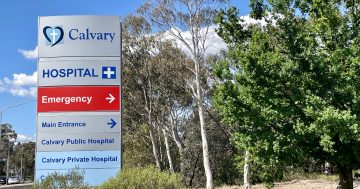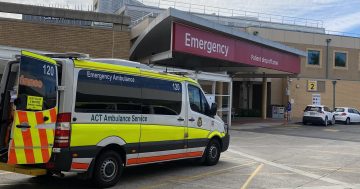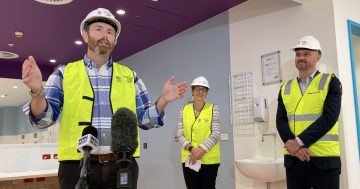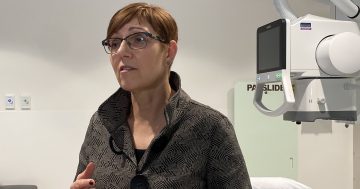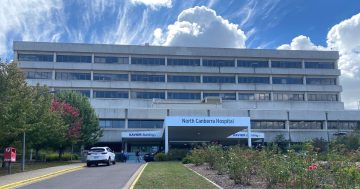
Canberra’s poor emergency department wait times have been a sore topic in the Territory for years. Photo: Claire Fenwicke.
The ACT still has the country’s worst emergency department and elective surgery wait times despite slight improvements in the last year.
The latest Productivity Commission’s Report on Government Services for Health showed the ACT was again last when it came to the time between people presenting to the emergency department (ED) and either being discharged or admitted: only 47.9 per cent of patients stayed for four hours or less (including both waiting and treatment times in the department).
This compares to the national average of 55.8 per cent and is worse than the 2021-22 data, which saw 52.4 per cent of Canberra’s patients seen within four hours.
There were improvements in the number of people seen on time in the ED compared to last year, with 41 per cent of ‘urgent’ patients seen within clinically recommended time frames (up from 36 per cent), 51 per cent of ‘semi-urgent’ patients seen on time (up from 46 per cent) and 76 per cent of ‘non-urgent’ patients seen on time (up from 73 per cent).
Overall, there have been improvements in the proportion of patients in the ACT seen on time, an increase from 48 per cent in 2021-22 to 51 per cent in 2022-23, and the median wait time has decreased.
Elective surgery wait times also increased, with 30 per cent of 2022-23 patients not admitted within clinically recommended times, up from 24.6 per cent in 2021-22.
Concerningly, the number of Canberrans avoiding seeing their GP has more than doubled from 3.7 per cent in 2021-22 to 8.1 per cent in 2022-23.
The number of people not filling out their necessary prescriptions due to the expense also rose from 3.3 per cent to 6.8 per cent in the same period.
However, the number of potentially avoidable GP-type presentations to EDs was down from 49,887 to 46,025 for 2022-23.
Health has long been a sore point in the Territory.
Deputy opposition leader and shadow health minister Leanne Castley slammed the statistics as a “disgrace” and “indictment” on the current government.
“Every year the Labor-Greens government has managed the health system, it has performed worse than the national average,” she said.
“This is embarrassing, but more importantly, it has a real impact on Canberrans’ health outcomes.”
Ms Castley accused the ACT Government of “excuses and spin” rather than coming up with solutions that worked.
“Each year we hear new excuses from the Health Minister about what she is doing to fix this crisis and each year she fails to improve the ACT’s ED wait times despite numerous promises,” she said.
“This year, Canberrans will be subjected to more propaganda from the government about everything it is doing in health, but Canberrans know their public health system is failing them.”
Health Minister Rachel Stephen-Smith acknowledged that while there is room for improvement, every health system across the country was under pressure.
“What this data does not specifically show and what the Canberra Liberals are not willing to acknowledge is that we have continued to see improvements with emergency department performance,” she said.
“The full-year 2022-23 data disguises improvements that were made through the year, with April-June 2023 emergency department figures tabled in the Legislative Assembly last year showing around 60 per cent of patients starting treatment on time.”
Ms Stephen-Smith also stressed ED wait times don’t reflect on the department alone and pointed out several initiatives being implemented by Canberra Health Services to improve processes across the entire hospital system.
These include an ED task force to improve patient flow in and out of the department, the introduction of an ED medical navigator role to support decision-making and flow on a shift-by-shift basis, expanding the acute medicine unit (AMU) and introducing Advanced Practice Nurses to work in the Fast Track area of the ED, focusing on patients triaged as category 4 or 5.
It’s intended their role will be expanded in the coming year to focus on ED-specific protocols.
As for elective surgery wait times, it has previously been outlined that the fire at the former Calvary Public Hospital Bruce’s operating theatres had some impact on the number of procedures being performed.
The last of those theatres came back online late last year.
Monthly performance was also impacted by the launch of the Digital Health Record (DHR) when 11,000 staff needed to be trained in its use.
“Following the launch of DHR, performance has been improving, and we have received very positive feedback from staff and consumers on the benefits of the new system,” Ms Stephen-Smith said.
More data from July to December 2023 is expected to be released in the first part of this year, which Ms Stephen-Smith said would show further improvements in ED ‘seen on time’ numbers.













